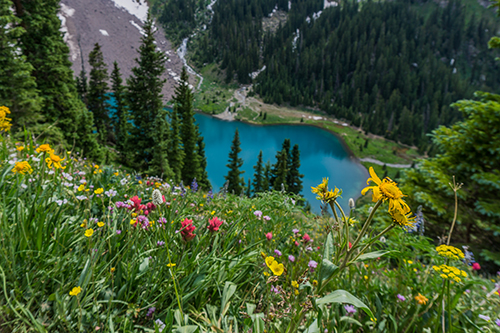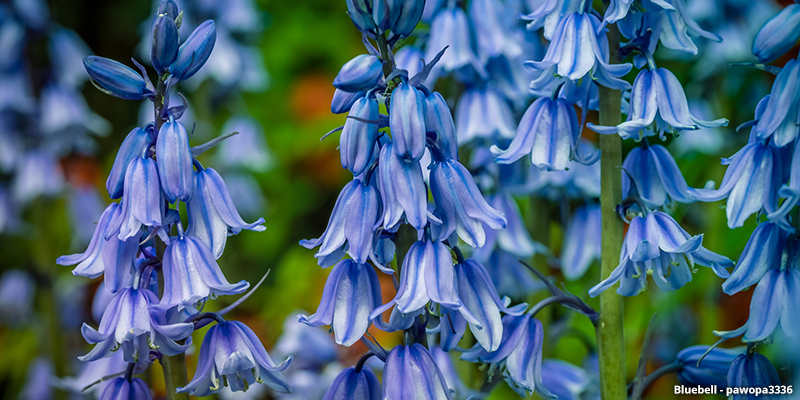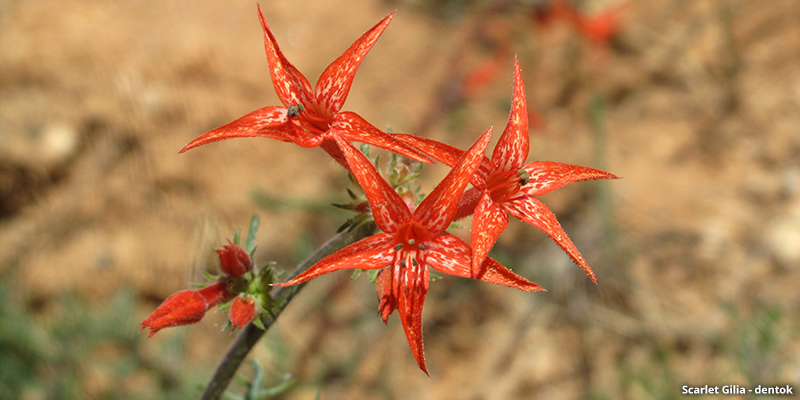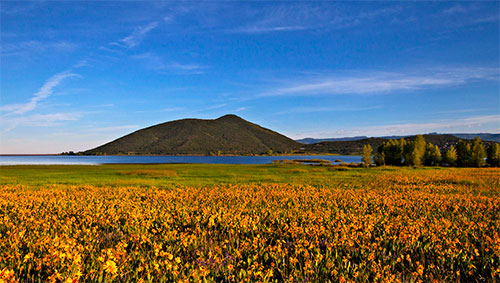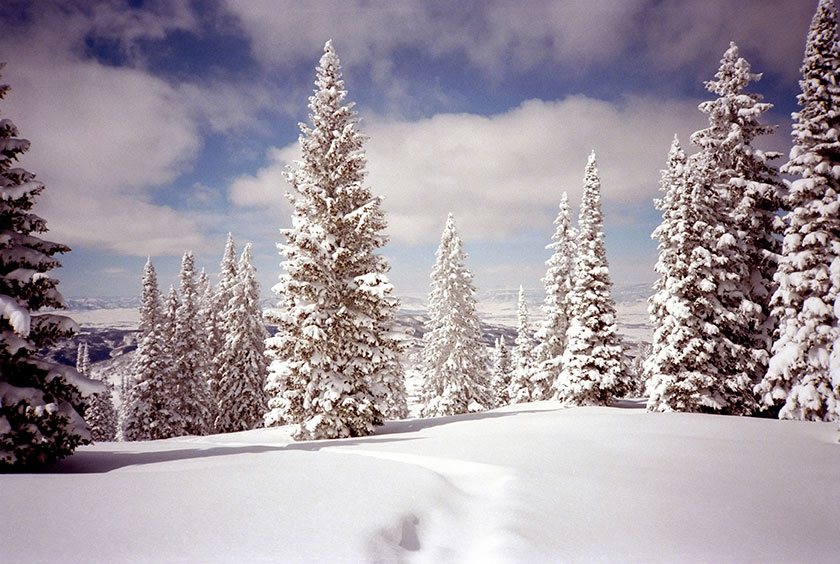A Colorado Wildflowers Guide
Colorado Wildflowers Guide
Use this Colorado Wildflowers Guide to locate beautiful wildflowers in early spring and throughout the warm weather seasons. Spring is a favorite season as wildflowers begin peering their heads up from the ground, and new life abounds. In the mountains, spring can be continuously enjoyed as this transformation is ongoing due to variables such as elevation and location. If gorgeous mountain wildflower blooms are what you’re looking for, we’re here to help you find them. If you are planning on being in the San Juan Mountain range, which is in southern Colorado, take a look at the San Juan Wildflower Guide for this region. Please check out these wildflower hiking recommendations for favorites.
Colorado Wildflowers: A Brief Field Guide
When you’re checking out wildflowers in Colorado, you’ll need to know what to look for. There are literally hundreds of beautiful wildflowers that grow in Colorado, but here’s a list of some of the most common:
Colorado Blue Columbine
The Rocky Mountain Columbine is a gorgeous blue and white star-shaped flower you’ll find all over the state, which is appropriate since it’s Colorado’s state flower.
Arrowleaf Balsamroot
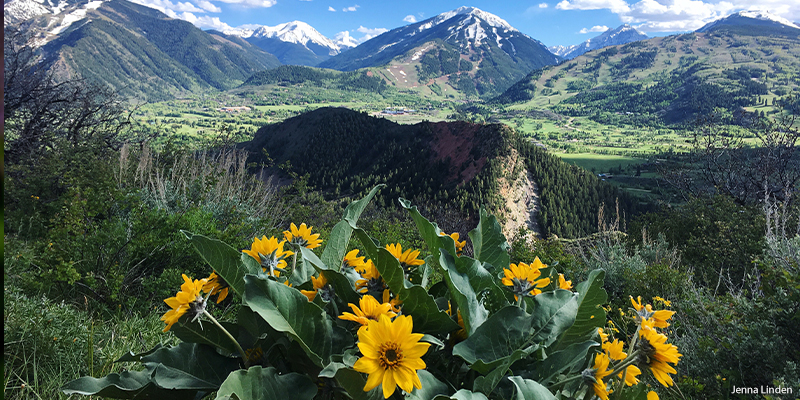
The arrowleaf balsamroot plant’s sunny yellow flowers in many parts of Colorado are a welcoming sign of spring. The flowers look a lot like mule’s ears, but if you look closely, you’ll notice some major differences. Meanwhile, mule’s ears have long, narrow leaves that are up to sixteen inches long and are shaped like mule ears. Arrowleaf balsamroot has leaves that are wider, about four inches wide, and less than a foot long. As the name suggests, these leaves are shaped like arrowheads. The flowers grow on long stalks, and after they die, the leaves and stalks dry up—you can see the dried, graying skeletons of last year’s growth beneath the greenery of this year’s plant.
Badlands Mule-Ears
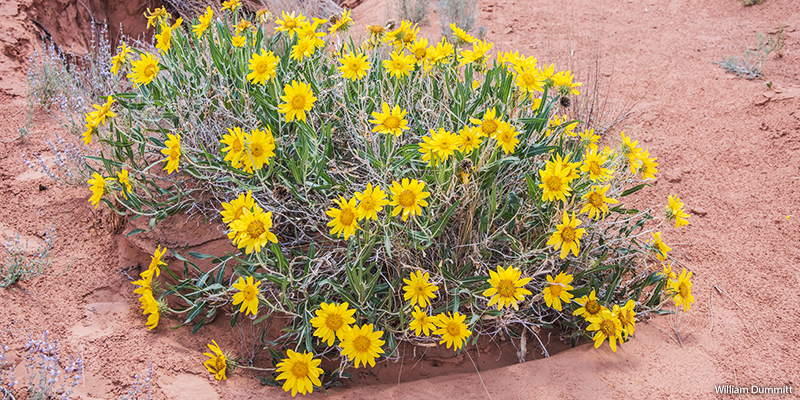
These large yellow blooms are found in higher elevation deserts; where there is sandy soil and a semi-desert climate. The leaves and stems are rough and scaly, and the broad flowers are about two inches wide. Larger plants grow in a bushy cluster full of cheerful yellow flowers.
Bitterroot

Bitterroot was discovered on the Lewis & Clark expedition and stood out to the explorers because the plant’s roots can be dug up, dried completely, stored for months, and then planted again. As you might expect from the name, the root of this plant is edible and quite bitter. The root goes dormant in the summer heat and starts activating in the fall, with leaves that remain green through the cold winter months and wither in the spring to be replaced with a short-stalked flower with pink petals that fade to white near the center. Bitterroot grows best in dry shrublands and piñon-juniper forests.
Blanketflower
This gorgeous bloom comes in shades of red, orange, and yellow, like a fiery tie-dyed sunflower.
Bluebell
Delicate bluebells look exactly like what the name implies.
Broadbeard Penstemon

These intensely blue flowers grow in clusters along a stalk up to a foot long. With blue-green leaves and delicate, 5-petaled flowers, broadbeard penstemon, also sometimes known as ‘whorled beardtongue,’ are easy to spot in the eastern plains and foothills of Colorado, usually in May and June.
Eastern Pasqueflower

This pretty flower is part of the buttercup family, and usually is one of the first signs of spring. It starts blooming around Easter or Passover in wet areas where snow is melting, anywhere from the foothills to subalpine regions of the state, and is unique because the flower blooms even before the leaves develop.
Elephant Head Lousewort
These little pink flowers, when viewed from the right angle, look just like the head of an elephant, trunk, ears, and all!
Fireweed
Fireweed gets its name from its ability to grow so quickly and prevalently in areas ravaged by wildfires, and since it can survive to a subalpine level of elevation, it blankets the ground on a lot of Colorado hikes.
Indian Paintbrush
This tall flower with its cup-like bracts comes in a variety of colors, but you’ll most likely spot the red and orange varieties in Colorado.
Lewis’ Blue Flax
Blue flax, or prairie flax as it’s sometimes called, is not only beautiful, but it’s also incredibly useful. The seeds are edible and often used for baking or making oils, and the long stems can be used to make linen. Another fun fact—blue is a particularly favorite color of pollinators like honeybees, who go crazy over this beautiful little bloom.
Periwinkle

Chances are if you haven’t seen this cute little flower out in the wild, you’ve seen it in one of your neighbor’s gardens. Periwinkles are not native Colorado wildflowers—they hail from Europe and are actually quite invasive. They do provide great ground cover in shady, wooded areas, and are quite beautiful.
Pink Mountain Heather
Pink Mountain Heather carries small pink blooms on a low, shrubby, bush-like plant. It grows at higher elevations in subalpine forests and meadows.
Rocky Mountain Bee Plant
This furry pink plant grows on a tall stem, and as the name implies, it attracts a lot of pollinators. Some of its other common names are less complimentary, like “skunk weed” or “stinking clover.”
Sand-dune Wallflower
Also known as “prairie rocket,” the sand-dune wallflower ranges in color from a light yellow to deep orange and prefers to grow in the dryer, hotter parts of the state.
Scarlet Gilia
Scarlet Gilia was first discovered by famous explorers Lewis and Clark in the mountains of Idaho during their expedition across the US. Each of its red, pink, or white flowers looks like a long tube with five petals at the end.
Sego Lily

In the grasslands and semi-desert climates of Colorado like the Four Corners region, the sego lily usually crops up in April. This plant grows from a bulb, more like an onion than anything, with a thin stem and delicate, tulip-like flowers that range in color from white to magenta to lavender.
Shooting Stars

Starting in April, depending on elevation, with a season that extends into August. Shooting stars are delicate and instantly recognizable, with swept-back purple petals behind a yellow center and a pointed black pistil that looks like a little dart. A single stem grows in a cluster called an umbel, and can have as many as 20 flowers. Shooting stars are very bee-friendly and grow all over, but in Colorado, they’re most often found in mountain meadows, especially near moisture.
Silky Lupine
They are hardy up to 11,000 feet elevation, so you can find them in plenty of areas in Colorado. Often found in the San Juan mountain range near Telluride.
Subalpine Larkspur
These grow best at 8,200 to 13,400 feet, and a fully mature plant can have dozens of gorgeous deep purple blooms on a single stalk.
White Marsh Marigold

Soon after the snow melts, the white marsh marigold appears along wetlands and riverbanks as one of the earliest harbingers of spring in the mountains. They are sometimes called “elks-lip” because of the shape of the broad, glossy leaves.
Wild Bergamot, aka Beebalm

Beebalm grows all over the US, but it’s perfectly suited for Colorado’s dry, sunny climate. Drought-tolerant, with spiky, colorful flowers that look a little like threadbare pompoms, beebalm is, as the name suggests, a very bee-friendly plant. You’ll find it in a lot of wildflower and pollinator seed packs, as well as out in the wild in alpine meadows.
Remember, this is just a sample of the many wildflowers you can find in Colorado, so use this list to get you started, but keep an eye out for more, because you’re sure to find them.
When to Find Colorado Wildflowers
Colorado wildflowers can be found throughout the landscape, from the flat prairie lands near Kansas to the subalpine meadows high up in the mountains. The higher your elevation, the later in the season they begin to bloom. Generally, the best time of year for spotting them on the plains is late spring or early summer. The best time to see them in the mountains is during July or August.
Where to Find Wildflowers in Colorado
Whether you’re hiking, biking, horseback riding, off-roading, or taking a scenic drive, you’re sure to spot some colorful flowers this summer, but if you’re specifically on the lookout for wildflowers, check out these wildflower hikes for some truly spectacular natural gardens.
by Emily Krempholtz
 |
 |
 |
||
Summer Activities >Summertime in Colorado is all about celebrating and enjoying the great outdoors. |
Lodging >Looking for a luxury hotel suite or a rustic cabin? We have something that’s perfect for you. |
Colorado Road Trips >Road trips are the best ways to experience all Colorado has to offer. |

